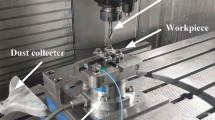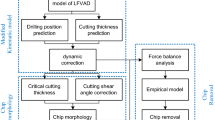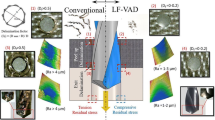Abstract
CFRP/Al stacks have shown a wide range of applications in the aviation industries. Component assembly requires an enormous number of holes to be drilled. In consideration of the quality and efficiency of the drilling process, it is preferred to change process parameters in real-time according to the different material properties of each ply, namely varying-parameter control. Since variable thickness designs are quite common in aviation structures, the interface of the stack is hard to define before the drilling process, which poses a challenge to interface recognition and parameter modification methods. Accordingly, a state-of-art self-adaptive drilling method based on the analysis of the equivalent impedance of a longitudinal-torsional–vibration-assisted drilling device is described in the paper. The research was carried out to implement online recognition of stack interface without using any sensors, as well as the following modification of process parameters. First, the equivalent impedance model was established by analyzing the characteristic signal of the piezoelectric transducer changing with the dynamic load. The representational capacity of equivalent impedance was verified through a drilling test, which showed five drilling stages could be divided using the established model. Furthermore, based on the mutation characteristic of equivalent impedance near the material interface, a threshold-based interface recognition algorithm was promoted. Modification of process parameters was also realized with a communication program. Finally, the self-adaptive drilling experiments were conducted. An average recognition depth error of 3.25% was observed, which meant the average thickness of 0.325 mm of the CFRP/Al stack was influenced by system response delay. The stability of the self-adaptive drilling system was verified under severe tool wear. The standard deviation of the recognition depth error was 0.112 mm. Compared with conventional vibration-assisted drilling, diameter deviation and surface quality of holes were considerably improved by 68.1% and 35.0%, respectively.


















Similar content being viewed by others
References
Phadnis VA, Roy A, Silberschmidt VV (2013) Ultrasonically assisted drilling: a finite-element model incorporating acoustic softening effects. J Phys Conf Ser 451:12040. https://doi.org/10.1088/1742-6596/451/1/012040
Al-wandi S, Ding S, Mo J (2017) An approach to evaluate delamination factor when drilling carbon fiber-reinforced plastics using different drill geometries: experiment and finite element study. Int J Adv Manuf Technol 93:4043–4061. https://doi.org/10.1007/s00170-017-0880-2
Girot F, Dau F, Gutiérrez-Orrantia ME (2017) New analytical model for delamination of CFRP during drilling. J Mater Process Technol 240:332–343. https://doi.org/10.1016/j.jmatprotec.2016.10.007
Bonnet C, Poulachon G, Rech J, Girard Y, Costes JP (2015) CFRP drilling: fundamental study of local feed force and consequences on hole exit damage. Int J Mach Tools Manuf 94:57–64. https://doi.org/10.1016/j.ijmachtools.2015.04.006
Barani A, Amini S, Paktinat H, Fadaei TA (2014) Built-up edge investigation in vibration drilling of Al2024-T6. Ultrasonics 54:1300–1310. https://doi.org/10.1016/j.ultras.2014.01.003
Bahçe E (2013) Experimental investigation of the effect of machining parameters on the surface roughness and the formation of built up edge (BUE) in the drilling of Al 5005. Tribol Eng. https://doi.org/10.5772/56027
Koklu U (2012) Influence of the process parameters and the mechanical properties of aluminum alloys on the burr height and the surface roughness in dry drilling. Mater Technol 46(2):103–108
Brinksmeier E, Janssen R (2002) Drilling of multi-layer composite materials consisting of carbon fiber reinforced plastics (CFRP), titanium and aluminum alloys. CIRP Ann 51:87–90. https://doi.org/10.1016/S0007-8506(07)61472-3
Ramulu M, Branson T, Kim D (2001) A study on the drilling of composite and titanium stacks. Compos Struct 54:67–77. https://doi.org/10.1016/S0263-8223(01)00071-X
Park K, Beal A, Kim DD, Kwon P, Lantrip J (2011) Tool wear in drilling of composite/titanium stacks using carbide and polycrystalline diamond tools. Wear 271:2826–2835. https://doi.org/10.1016/j.wear.2011.05.038
Zitoune R, Krishnaraj V, Sofiane Almabouacif B, Collombet F, Sima M, Jolin A (2012) Influence of machining parameters and new nano-coated tool on drilling performance of CFRP/Aluminium sandwich. Compos B Eng 43:1480–1488. https://doi.org/10.1016/j.compositesb.2011.08.054
Kim D, Ramulu M (2004) Drilling process optimization for graphite/bismaleimide–titanium alloy stacks. Compos Struct 63:101–114. https://doi.org/10.1016/S0263-8223(03)00137-5
Pramanik A, Littlefair G (2014) Developments in machining of stacked materials made of CFRP and titanium/aluminum alloys. Mach Sci Technol 18:485–508. https://doi.org/10.1080/10910344.2014.955718
Zitoune R, Krishnaraj V, Collombet F, Le Roux S (2016) Experimental and numerical analysis on drilling of carbon fibre reinforced plastic and aluminium stacks. Compos Struct 146:148–158. https://doi.org/10.1016/j.compstruct.2016.02.084
Jia Z, Chen C, Wang F, Zhang C, Wang Q (2020) Analytical model for delamination of CFRP during drilling of CFRP/metal stacks. Int J Adv Manuf Technol 106:5099–5109. https://doi.org/10.1007/s00170-020-05029-y
Janakiraman A, Pemmasani S, Sheth S, Kannan C, Balan ASS (2020) Experimental investigation and parametric optimization on hole quality assessment during drilling of CFRP/GFRP/Al stacks. J Inst Eng (India) Ser C 101:291–302. https://doi.org/10.1007/s40032-020-00563-w
Cheng H, Zhang K, Wang N, Luo B, Meng Q (2017) A novel six-state cutting force model for drilling-countersinking machining process of CFRP-Al stacks. Int J Adv Manuf Technol 89:2063–2076. https://doi.org/10.1007/s00170-016-9236-6
Impero F, Dix M, Squillace A, Prisco U, Palumbo B, Tagliaferri F (2018) A comparison between wet and cryogenic drilling of CFRP/Ti stacks. Mater Manuf Process 33:1354–1360. https://doi.org/10.1080/10426914.2018.1453162
Chern G, Wu YE, Liu S (2006) Development of a micro-punching machine and study on the influence of vibration machining in micro-EDM. J Mater Process Technol 180:102–109. https://doi.org/10.1016/j.jmatprotec.2006.05.010
Egashira K, Masuzawa T (1999) Microultrasonic machining by the application of workpiece vibration. CIRP Ann 48:131–134. https://doi.org/10.1016/S0007-8506(07)63148-5
Shamoto E, Moriwaki T (1994) Study on elliptical vibration cutting. CIRP Ann 43:35–38. https://doi.org/10.1016/S0007-8506(07)62158-1
Wang X, Wang LJ, Tao JP (2004) Investigation on thrust in vibration drilling of fiber-reinforced plastics. J Mater Process Technol 148:239–244. https://doi.org/10.1016/j.jmatprotec.2003.12.019
Cong WL, Zou X, Deines TW, Wu N, Wang X, Pei ZJ (2012) Rotary ultrasonic machining of carbon fiber reinforced plastic composites: an experimental study on cutting temperature. J Reinf Plast Compos 31:1516–1525. https://doi.org/10.1177/0731684412464913
Sanda A, Arriola I, Garcia Navas V, Bengoetxea I, Gonzalo O (2016) Ultrasonically assisted drilling of carbon fibre reinforced plastics and Ti6Al4V. J Manuf Process 22:169–176. https://doi.org/10.1016/j.jmapro.2016.03.003
Geng D, Zhang D, Li Z, Liu D (2017) Feasibility study of ultrasonic elliptical vibration-assisted reaming of carbon fiber reinforced plastics/titanium alloy stacks. Ultrasonics 75:80–90. https://doi.org/10.1016/j.ultras.2016.11.011
Kuo C, Li Z, Wang C (2017) Multi-objective optimisation in vibration-assisted drilling of CFRP/Al stacks. Compos Struct 173:196–209. https://doi.org/10.1016/j.compstruct.2017.04.026
Shao Z, Jiang X, Geng D, Liu Y, Zhou Z, Li S, Zhang D et al (2021) The interface temperature and its influence on surface integrity in ultrasonic-assisted drilling of CFRP/Ti stacks. Compos Struct 266:113803. https://doi.org/10.1016/j.compstruct.2021.113803
Shyha I, Soo SL, Aspinwall DK, Bradley S, Dawson S, Pretorius CJ (2010) Drilling of titanium/CFRP/aluminium stacks. Key Eng Mater 447–448:624–633. https://doi.org/10.4028/www.scientific.net/KEM.447-448.624
Neugebauer R, Ben-Hanan U, Ihlenfeldt S, Wabner M, Stoll A (2012) Acoustic emission as a tool for identifying drill position in fiber-reinforced plastic and aluminum stacks. Int J Mach Tools Manuf 57:20–26. https://doi.org/10.1016/j.ijmachtools.2012.01.013
Fang Q, Pan Z, Han B, Fei S, Xu G, Ke Y (2015) A force sensorless method for CFRP/Ti stack interface detection during robotic orbital drilling operations. Math Probl Eng 2015:1–11. https://doi.org/10.1155/2015/952049
Funding
The work in this paper was supported by the National Natural Science Foundation of China (NSFC) under grant number 51675277 and by the High-level Talents Project of the “six talents summit” in Jiangsu under grant number GDZB-011.
Author information
Authors and Affiliations
Contributions
Methodology and formal analysis were performed by Xin Hu; the first draft of the manuscript was written by Xin Hu, and all authors commented on previous versions of the manuscript. Supervision, resources preparation, and conceptualization were performed by Chen Zhang. Investigation and data curation were performed by Shengcai Wang. Validation was performed by Fuhang Yu and Zixuan Wang. The revision was performed by Xin Hu. All authors read and approved the final manuscript.
Corresponding author
Ethics declarations
Competing interests
The authors declare no competing interests.
Additional information
Publisher's Note
Springer Nature remains neutral with regard to jurisdictional claims in published maps and institutional affiliations.
Rights and permissions
Springer Nature or its licensor holds exclusive rights to this article under a publishing agreement with the author(s) or other rightsholder(s); author self-archiving of the accepted manuscript version of this article is solely governed by the terms of such publishing agreement and applicable law.
About this article
Cite this article
Hu, X., Zhang, C., Wang, S. et al. Investigation of self-adaptive drilling of CFRP/Al stacks based on equivalent impedance recognition of the vibration-assisted device. Int J Adv Manuf Technol 123, 1641–1656 (2022). https://doi.org/10.1007/s00170-022-10267-3
Received:
Accepted:
Published:
Issue Date:
DOI: https://doi.org/10.1007/s00170-022-10267-3




